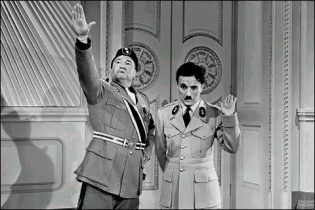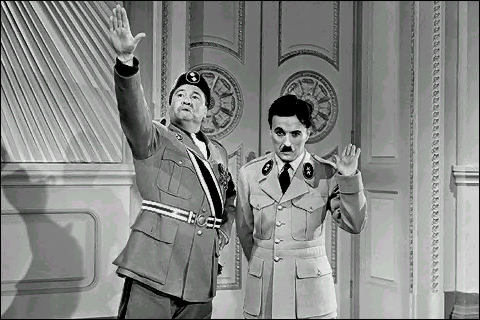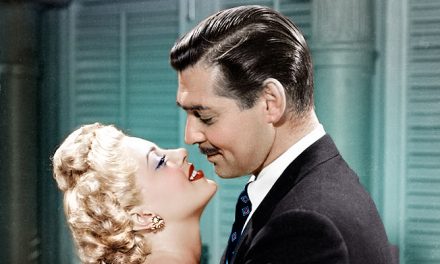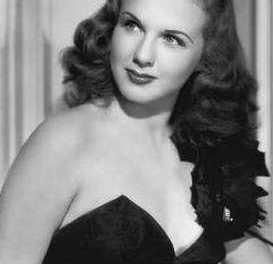It may seem strange to review a movie that is already several years old, but some movies have a certain alluring nature about them. Some movies can not only make us laugh but also allow us to better understand the world we live in.
“The Great Dictator” follows the paths of two men: one, an unnamed Jewish barber, and the other, a dictator by the name of Adenoid Hynkel. The barber spends the movie fighting and arguing with men clearly representing Nazis in Chaplin’s classic slapstick comedy method. Hynkel is the halfwit leading the nation of Tomania, allows infighting between the Jews and Tomanian nationals, fails to keep foreign relations steady, and makes a mess of his government all while following the same Chaplin comedy style.

Jack Oakie and Charlie Chaplin while filming The Great Dictator. From Wikimedia Commons.
The film opens with two bodies of text being plastered on the screen, one showing the comedic nature of the film, and the other showing the serious undertones that pervade it. The first, referencing the two main characters, states that “any resemblance between Hynkel the dictator and the Jewish barber is purely co-incidental,” showing Chaplin’s bold acceptance of his attempt to defame Adolf Hitler through satire.
The more serious quote, which also stood momentarily on the screen before the film, stated as follows: “This is a story of a period between two World Wars—an interim in which Insanity cut loose. Liberty took a nose dive, and Humanity was kicked around somewhat.” Here, we can see that the film touches on matters far more important than your common funny picture show. This piece goes into a satirical view of the matters that led up to this dreadful war, making a mockery of the very man that got the world into this mess.
Chaplin’s use of symbolism throughout the movie went beyond just entertainment. His transformation of the swastika into the double-cross (two black X’s contained within a white circle) was probably the most prominent of these, as it is displayed constantly throughout the film. The characters’ names represent another jab at the Nazis, with Hynkel replacing Hitler, and Garbitsch (sounds like “garbage”) and Herring replacing Goebbels and Göring. The details of the film itself also stay true to the events that led up to the war, such as the tense relationship between the Germans (Tomanians) and the Italians (Bacterians) before the war started. The strangeness of this anger, then immediate friendship, all leading up to the annexation of Austria, has for years seemed strange. This film puts them into light, showing an interpretation of how these matters were settled in the eyes of a comedian and a satirist.
Chaplin’s ability to play two characters was brilliant; his performance as the Jewish barber pointed a light at the mistreatment of the Jewish population by the German government. This barber is a fighter, attempting to fight back constantly toward the brown shirts wearing their double-crosses, only to find he’s nearly always outnumbered. Chaplin’s final act in the movie culminates with the barber finding himself mistaken for the dictator Hynkel. While I will not give away the details of this speech, I will say that his words spoke for many in regard to this conflict, expressing a desire to see a world without such pain and violence. Perhaps, some day soon, we will see Chaplin’s dream come true.
I would suggest that anyone who has the time see this movie. It will not only make you laugh, but perhaps even give you a deeper understanding of the conflict we now find ourselves in.





